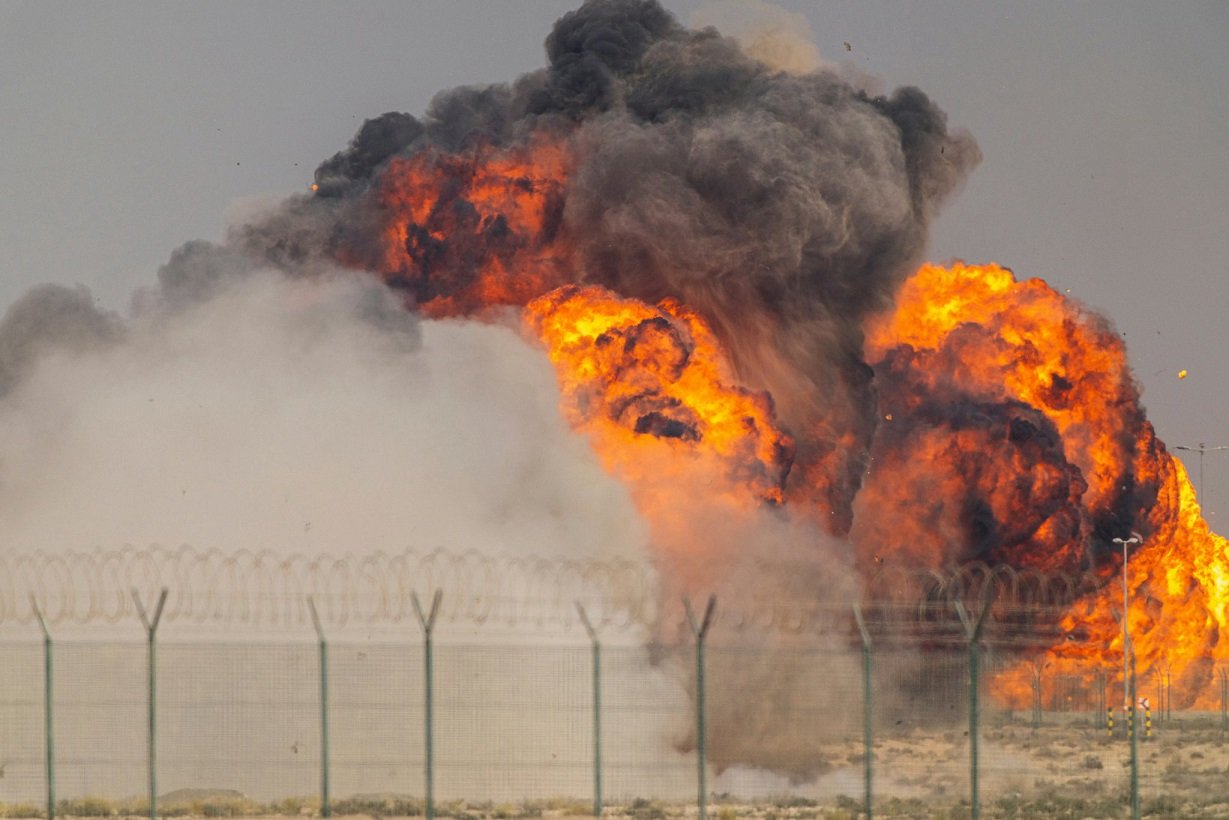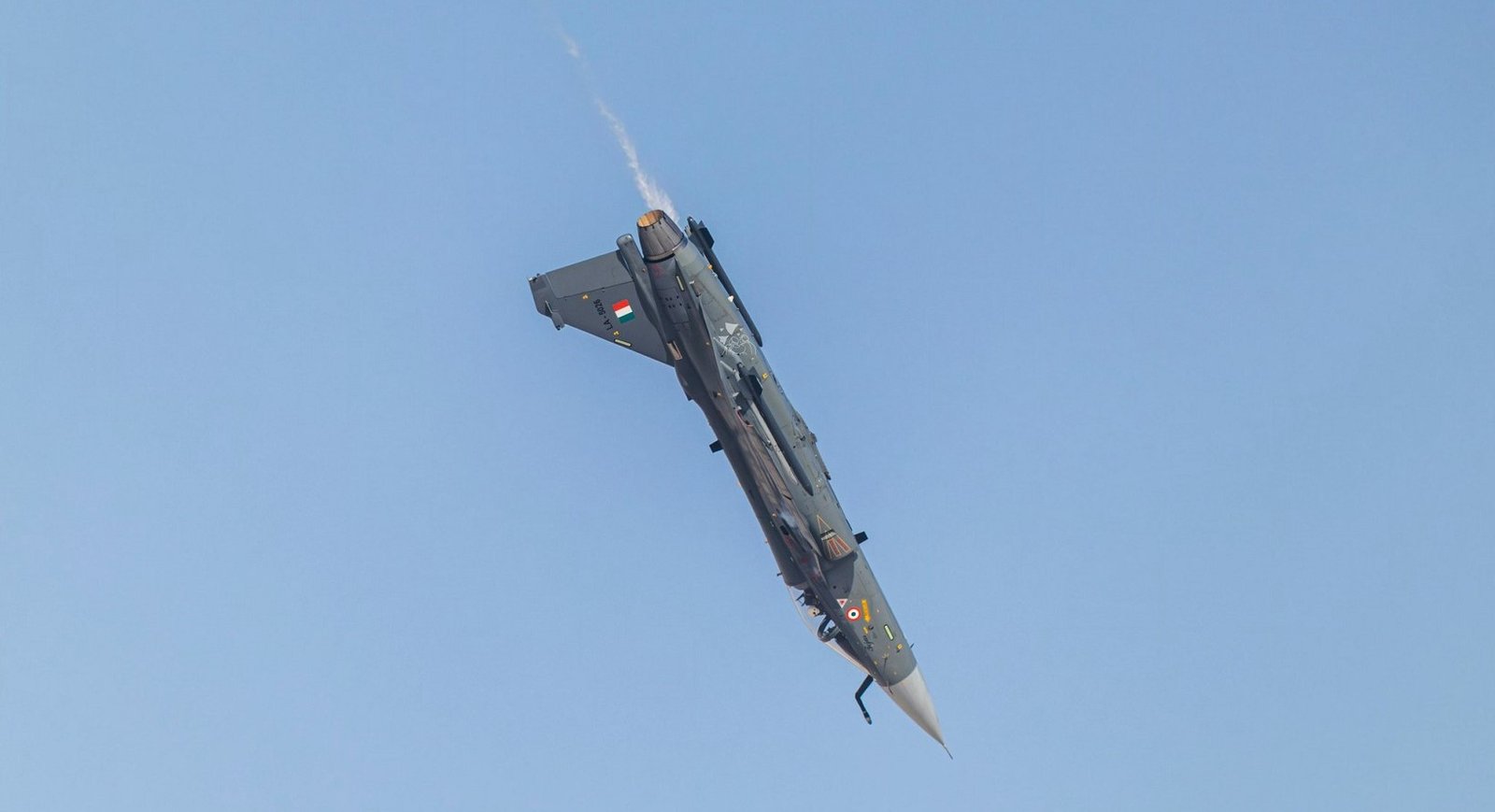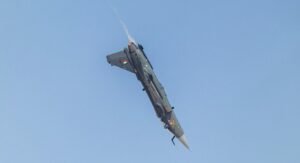Tejas: a tale of a failed fighter jet best describes India’s struggle to design, build, and perform with an indigenous combat aircraft. What started as a national dream in the early 1980s eventually became a symbol of delays, cost overruns, technical failures, and repeated disappointments.
Although India wanted Tejas to replace outdated MiG-21 jets and strengthen its air power, the long development cycle and the jet’s underperformance continue to raise doubts even in 2025.
This article explains the complete history, every major problem, all known crashes, production challenges, and what actually happened at the Dubai Airshow 2025. Each section is detailed so the full journey is clear from start to end.
The Origin of the Tejas Program (1983–1990)

India started the LCA program in 1983 with the ambition of replacing MiG-21 jets. The government believed Tejas would create a new era of aviation independence. However, the nation underestimated the complexity of designing a modern fighter jet, especially without a strong technological base. This early miscalculation set the stage for decades of delay.
Formation of ADA
The Aeronautical Development Agency (ADA) was formed to lead the project, but the agency lacked the skilled workforce needed for such an advanced aircraft. Engineers had to build expertise from the ground up. This slowed early progress, with essential technologies still years away from being developed or acquired.
Unrealistic Deadlines
Program timelines were highly unrealistic. The government expected Tejas to be operational within 10 years. In reality, no country without earlier experience could meet such a deadline. Pressure from political leaders created rushed decision-making, poor planning, and numerous redesigns that turned the schedule into a never-ending cycle of delays.
Early Technical Problems
Engineers faced major setbacks trying to integrate fly-by-wire technology without prior experience. Composite materials were new, and India lacked manufacturing units capable of handling them. Every system, from controls to structure, required modifications. These early struggles made experts doubt the feasibility of completing the aircraft in the planned timeframe.
Development Phase: Endless Delays (1990–2001)

Throughout the 1990s, Tejas faced constant setbacks. Each improvement revealed new weaknesses, which pushed the project further behind schedule. Instead of progressing, the aircraft entered a loop of testing, failing, redesigning, and retesting. This period showed that India had severely underestimated the learning curve of fighter jet development.
The First Prototype (1995)
Although celebrated, the first prototype exposed numerous structural issues. Engineers discovered stability problems during high-speed maneuvers. The aircraft struggled to control angle of attack and yaw. These serious issues forced the team to redesign several components, pushing the program multiple years behind the revised schedule.
The Second Prototype (1998)
The second prototype was heavier and required multiple flight control software upgrades. Pilots reported uneven handling and sluggish responsiveness. Several subsystems malfunctioned during test runs, such as the power supply and navigation modules. Each failure demanded months of debugging, extending development far past the intended deadlines.
Foreign Assistance Became Necessary
India had to buy foreign fly-by-wire systems, pressure sensors, actuators, and radar modules. This contradicted the aircraft’s indigenous goal. Depending on imported systems created vulnerabilities in supply, delays in delivery, and increased cost. It also weakened India’s claim that Tejas was a domestically built fighter.
Cost Overruns
By the late 1990s, the budget had ballooned far beyond the initial allocation. Each redesign required more money, and foreign components further increased costs. Funding mismanagement created internal conflicts between ADA, HAL, and the defence ministry. Even after spending heavily, the aircraft still lacked essential capabilities.
Engine Failure: Collapse of Kaveri
The Kaveri engine is one of the biggest failures in Indian aerospace history. It was meant to power Tejas, making the aircraft fully indigenous. However, its consistent failure dragged the program back for decades and forced India into dependency on American engines.
Why Kaveri Failed
During testing, the Kaveri engine produced insufficient thrust and overheated frequently. Engineers tried improving turbine blades, fuel injectors, and combustion chambers but failed to achieve required performance. Its inability to support afterburner operations made it impossible for Tejas to meet fighter-grade standards.
Billions Spent, No Engine Delivered
Despite billions in investment, the Kaveri engine never reached operational status. Test results showed unacceptable vibration levels during high-speed rotations. This failure destroyed India’s dream of a fully indigenous jet and significantly increased the overall cost of the LCA program, pushing reliance on foreign engines.
Dependency on American Engine
The GE-404 engine became the only option for Tejas. While reliable, the engine made Tejas heavily dependent on American technology and export permissions. This hurt India’s export ambitions because potential buyers feared U.S. restrictions, making Tejas a risky option for global markets.
First Flight and Limited Progress (2001–2010)
Even after its maiden flight in 2001, Tejas entered another decade of repeated test failures. The aircraft struggled with stability, avionics integration, and weapon compatibility. Its progress remained painfully slow, making the Air Force skeptical about the aircraft’s future performance.
First Flight (2001)
The first flight generated national pride, but inside the program, engineers knew the aircraft was far from ready. The jet displayed limitations in acceleration, climb rate, and turning capability. Test pilots reported early signs of structural vibration and unreliable flight control behavior.
Years of Testing Troubles
Between 2001 and 2010, more than 1,500 test flights were conducted. Many flights were aborted due to software glitches, unstable gyro readings, and unexpected sensor failures. Engineers had to rework wiring, replace components, and rewrite code repeatedly to address errors.
Safety Concerns
Several emergency landings were reported during this phase. Heat from the engine caused insulation breakdown. Hydraulics misbehaved under high pressure. Pilots complained about limited visibility from the cockpit and poor ergonomics. These problems raised serious operational concerns about the aircraft’s safety.
Final Operational Clearance Delayed (2010–2019)

Tejas took nearly nine years to achieve Final Operational Clearance (FOC), making it one of the slowest certification programs of any modern fighter. This raised deep concerns about India’s defense manufacturing capability.
Weapon System Failures
Weapons integration took much longer than expected. Laser bombs failed to maintain accuracy. Air-to-air missiles did not sync with Tejas’s targeting software. Trials had to be repeated several times, delaying acceptance by the Air Force.
Mid-Air Issues
In multiple flights, the aircraft experienced sudden power loss and avionics shutdown. These mid-air failures forced pilots to return immediately. Engineers struggled to trace these issues as they appeared irregularly, making diagnostics difficult.
Radar Troubles
The indigenous radar failed to meet military requirements, forcing India to import Israeli radars. Even then, integration was slow. The radar frequently returned inaccurate readings in bad weather or low visibility, making the jet unreliable for real combat scenarios.
FOC in 2019
After decades of delays, Tejas received FOC in 2019. However, even after clearance, the aircraft lacked several features promised in the original design, including advanced electronic warfare systems and full missile integration.
HAL’s Production Problems
HAL’s inability to scale production became one of the biggest weaknesses of the Tejas project.
Slow Manufacturing
HAL’s assembly line struggled to produce even six to eight jets per year. Inefficiencies in the supply chain, worker shortages, and outdated manufacturing tools slowed progress. The Air Force repeatedly complained about delayed delivery schedules and unfinished aircraft.
Quality Control Issues
Many Tejas units failed quality inspections due to loose fittings, electrical mismatches, or substandard parts. Components had to be replaced frequently, increasing project costs and causing delays. Defence auditors criticised HAL’s inconsistent production standards.
Air Force Frustration
The Indian Air Force, which urgently needed modern jets, became increasingly frustrated with the slow pace. Senior officers stated that Tejas could not fill combat gaps and expressed concerns that relying on Tejas would weaken national security.
Crashes and Technical Failures
Crashes and emergency cases created fear among pilots, limiting the jet’s usage.
Engine Flameouts
Engine flameouts occurred during several high-altitude tests, forcing pilots into emergency procedures. Engineers linked these incidents to inconsistent fuel pressure and inadequate airflow within the engine intake.
Fuel System Failures
Fuel pumps malfunctioned in mid-flight, which caused sudden loss of thrust. Faulty sensors returned incorrect fuel readings, making pilots unsure of their actual fuel levels. This became a major safety risk.
Landing Gear Problems
Landing gear frequently jammed or deployed late. In some cases, the aircraft landed with unstable gear positions. Engineers had to reinforce the gear structure and replace weak hydraulic components.
Cockpit Smoke
Smoke entering the cockpit during test flights alarmed pilots. Investigations suggested wiring overheating behind the display panel. This issue required multiple redesigns of the electrical system.
Operational Weaknesses
Even after induction, Tejas lagged behind competitors.
Limited Range
The aircraft’s limited fuel capacity reduced mission range, making it unsuitable for long-distance or deep-strike missions. Mid-air refueling became essential, but Tejas lacked reliable refueling probes in its early versions.
Weak Payload Capacity
The jet carries fewer weapons than competitors in the same class. This reduced its ability to perform multi-role missions effectively and limited its usefulness in real combat environments.
Sensor and Radar Limitations
Tejas’s radar system struggled with detecting low-signature targets. Its defensive sensors were basic, and the jet couldn’t operate sophisticated electronic warfare systems. This made it vulnerable in modern air combat.
No Combat Experience
Tejas never participated in real combat, leaving its battlefield performance untested. Without a combat record, international buyers remain cautious.
Export Failures

Tejas was marketed globally but attracted no confirmed buyers.
Malaysia Rejection
Malaysia selected the Korean FA-50 due to Tejas’s maintenance issues, slow production rate, and reliance on American engines. Malaysian officials highlighted concerns about long-term support.
Sri Lanka Withdrawal
Sri Lanka decided against buying Tejas due to economic issues and concerns about supply delays from HAL. The country preferred used aircraft from established suppliers.
Egypt and Argentina Hesitation
Both nations hesitated because Tejas lacked proven reliability and had political complications due to its American engine. They also considered other jets with stronger combat history.
Dubai Airshow 2025 Failure
The Dubai Airshow 2025 became a critical moment for Tejas — and it did not go well.
Static Display Concerns
Visitors observed outdated avionics and limited cockpit features. Competing jets showcased advanced displays, sensors, and weapon systems that made Tejas appear behind modern standards.
Weak Flight Demonstration
Tejas’s flight lacked high-performance manoeuvres. Spectators saw basic turns and climbs instead of aggressive aerobatics. Experts commented that the jet did not demonstrate the agility expected from a modern fighter.
Expert Criticism
Analysts criticised Tejas’s engine power, radar range, and payload. Some noted that the aircraft looked more like a trainer than a combat aircraft compared to international competitors.
No Export Interest
India expected Dubai to bring buyers. Instead, foreign delegates showed little interest, and no follow-up queries were reported after the show.
Attempts to Improve Tejas
India continues to upgrade the jet, but progress remains slow.
Tejas Mk1A
Promoted as an improved version, Mk1A promises updated radar, sensors, and avionics. However, production delays continue, and the Air Force still lacks clarity on timelines.
Tejas Mk2
The Mk2 aims to fix weight issues, add a stronger engine, and expand mission roles. Yet its development is far from completion, and delays raise doubts about its future.
Persistent Delays
Even with new funding, Tejas upgrades face old problems: slow manufacturing, heavy dependence on imports, and lack of tested systems.
Why Tejas Is Still Called a “Failed Fighter Jet”
The label “Tejas: a tale of failed fighter jet” comes from:
- 40+ years of delays
- Billions in cost overruns
- Failed engine program
- Slow production
- Limited capabilities
- Weak radar and payload
- No export success
- Crashes and emergencies
- Poor global performance, including Dubai Airshow 2025
Tejas represents ambition, but also repeated failure.
FAQs — Tejas Fighter Jet
Why did the Tejas fighter jet face so many delays?
Tejas faced delays because the project relied on new technologies that India had never built before. Limited budgets, evolving design standards, and repeated testing requirements added more slowdowns. Every time a new issue appeared, engineers had to redesign parts, which extended the timeline.
What makes Tejas different from other light fighter jets?
Tejas is built with a high percentage of composite materials, and its size is smaller than many jets in its category. It uses a digital flight-control system and tries to fit advanced avionics into a compact airframe. However, these innovations also created integration challenges that other older jets did not face.
Is the Tejas MK1 still used by the Indian Air Force?
Yes, the Indian Air Force operates squadrons that fly the Tejas MK1. Although it has shortcomings, the aircraft remains part of training and limited operational roles. The IAF often uses it for routine patrols and exercises, not high-risk combat missions.
Why did some countries show interest but not buy Tejas?
Countries like Malaysia and Egypt reviewed Tejas but chose other jets because of service limitations, maintenance concerns, and slow production rates. Buyers prefer aircraft with established performance records, long-term support, and proven combat use—areas where Tejas struggles to compete.
Will future versions like Tejas MK2 solve current problems?
The MK2 version plans to use a stronger engine, larger frame, and upgraded radar. These changes aim to fix earlier problems, but the jet is still in development. Success depends on testing results, production speed, and India’s ability to keep costs under control.
Conclusion: The Story of Tejas Remains Unresolved
Tejas is not just an aircraft. It is a symbol of India’s ambition and struggle. The dream continues, but so do the challenges. India invested decades in this program, yet the fighter still struggles to meet global standards. The aircraft may improve in the future, but its history remains a long record of disappointment.
For now, the story continues as Tejas: a tale of a failed fighter jet, shaped by delays, technical issues, production failures, crashes, and an underwhelming performance at the Dubai Airshow 2025.







